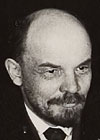A Dozen Images of Lenin
 Lenin and his followers always had a supreme understanding of the power of images. Only a few months after they came to power in October 1917, the Bolsheviks began to choose new symbols to engrave on the collective memory: the hammer and sickle and the red star.
Lenin and his followers always had a supreme understanding of the power of images. Only a few months after they came to power in October 1917, the Bolsheviks began to choose new symbols to engrave on the collective memory: the hammer and sickle and the red star.
The idea of a Lenin museum was born as early as 1920, and the museum opened in 1924, the year Lenin died. The immediate establishment of a mausoleum reinforced the impression of Lenin's superhuman qualities. Images of Lenin appear early on political posters. It is said that during official photo sessions Lenin repeatedly joked, "This is not the dictatorship of the proletariat, this is the dictatorship of photography". In the iconography we see Lenin dressed either in a coarse-threaded coat with a cap on his head, or bareheaded wearing a suit and vest. In the first instance he is seen as a man of the people, a revolutionary and worker, in the second as an inspiring statesman.
Lenin died at a young enough age so that he remained a venerated symbol of the communist movement for several scores of years, both within the Soviet Union and abroad, as the 'Leniniana' from the IISH collections shown here testify.
This selection was taken from Images of Aspiration / Beelden van Streven, a documentary based on images from social movements, written by Huub Sanders and Els Hiemstra, a memorial book on the occasion of the Institute's 70th birthday in 2005.
Huub Sanders and Els Hiemstra, Images of aspiration / beelden van streven (Amsterdam, Aksant 2005)
View all images (ca. 636) of Lenin in the IISH-collections.
